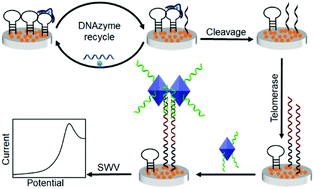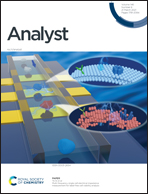A stepwise recognition strategy for the detection of telomerase activity via direct electrochemical analysis of metal–organic frameworks
Abstract
The detection of telomerase is of great significance for monitoring cell canceration. The conventional methods depend on the extension of telomerase towards its primer to conduct signal transduction. Herein, a specific and reliable detection strategy based on stepwise recognition was developed for tandem detection of metal ions and enzymes. We first synthesized an electrically active metal–organic framework (MIL-101(Fe)), which can act directly as a signal reporter in phosphate buffered saline after being modified with capture DNA (cDNA). When the zinc ion is added as a coenzyme factor, the modified hairpin DNA on the electrode is cleaved by DNAzyme to yield the activated primer. After the addition of telomerase, the cleaved DNA strand would be extended, and the resulting sequence will be hybridized with the signal label of MIL-101(Fe)–cDNA. Therefore, a signal-on strategy for the detection of telomerase was achieved based on the direct electrochemical analysis of MIL-101(Fe). Moreover, this electrochemical biosensor can discriminate telomerase activity among different cell lines. The stepwise recognition ensured the advantages of an electrochemical biosensor such as high sensitivity and specificity during the detection process, providing a novel method for monitoring and diagnosis of diseases.

- This article is part of the themed collections: Analyst Recent HOT articles and Celebrating 100 years of Chemistry at Nanjing University


 Please wait while we load your content...
Please wait while we load your content...